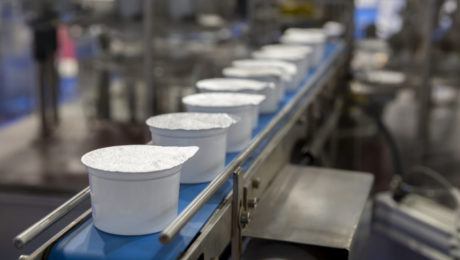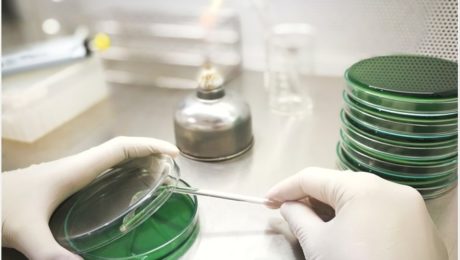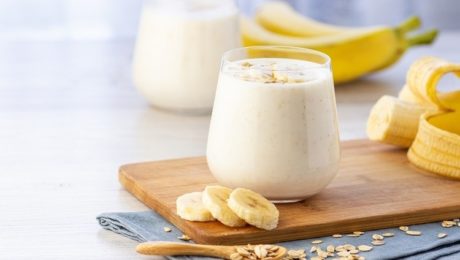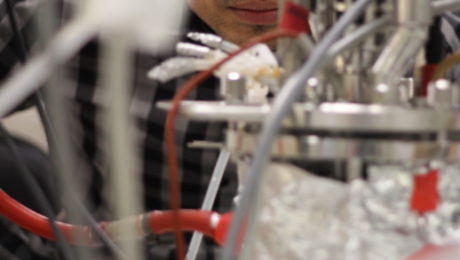Managing Fermented Food Microbes to Control Quality
Fermented foods are produced through controlled microbial growth — but how do industry professionals manage those complex microorganisms? Three panelists, each with experience in a different field and at a different scale — restaurant chef, artisanal cheesemaker and commercial food producer — shared their insights during a TFA webinar, Managing Fermented Food Microbes to Control Quality.
“Producers of fermented foods rely on microbial communities or what we often call microbiomes, these collections of bacteria yeasts and sometimes even molds to make these delicious products that we all enjoy,” says Ben Wolfe, PhD, associate professor at Tufts University, who moderator the webinar along with Maria Marco, PhD, professor at University of California, Davis (both are TFA Advisory Board members).
Wolfe continued: “Fermenters use these microbial communities every day right, they’re working with them in crocks of kimchi and sauerkraut, they’re working with them in a vat of milk as it’s gone from milk to cheese, but yet most of these microbial communities are invisible. We’re relying on these communities that we rarely can actually see or know in great detail, and so it’s this really interesting challenge of how do you manage these invisible microbial communities to consistently make delicious fermented foods.”
Three panelists joined Wolfe and Marco: Cortney Burns (chef, author and current consultant at Blue Hill at Stone Barns in New York, a farmstead restaurant), Mateo Kehler (founder and cheesemaker at Jasper Hill in Vermont, a dairy farm and creamery) and Olivia Slaugh (quality assurance manager at wildbrine | wildcreamery in California, producers of fermented vegetables and plant-based dairy).
Fermentation mishaps are not the same for producers because “each kitchen is different, each processing facility, each packaging facility, you really have to tune in to what is happening and understand the nuance within a site,” Marco notes. “Informed trial and error” is important.
The three agreed that part of the joy of working in the culinary world is creating, and mistakes are part of that process.
“We have learned a lot over the years and never by doing anything right, we’ve learned everything we know by making mistakes,” says Kehler.
One season at Jasper Hill, aspergillus molds colonized on the rinds of hard cheeses, spoiling them. The cheesemakers discovered that there had been a problem early on as the rind developed. They corrected this issue by washing the cheese more aggressively and putting it immediately into the cellar.
“For the record, I’ve had so many things go wrong,” Burns says. A koji that failed because a heating sensor moved, ferments that turned soft because the air conditioning shut off or a water kefir that became too thick when the ferment time was off. “[Microbes are] alive, so it’s a constant conversation, it’s a relationship really that we’re having with each and every one on a different level, and some of these relationships fall to the wayside or we forget about them or they don’t get the attention they need.”
Burns continues: “All these little safeguards need to be put in place in order for us to have continual success with what we’re doing, but we always learn from it. We move the sensor, we drop the temperature, we leave things for a little bit longer. That’s how we end up manipulating them, it’s just creating an environment that we know they’re going to thrive in.”
Slaugh distinguishes between what she calls “intended microbiology” — the microbes that will benefit the food you’re creating — and “unintended microbiology” — packaging defects, spoilage organisms or a contamination event.
Slaugh says one of the benefits of working with ferments at a large scale at wildbrine is the cost of routine microbiological analysis is lower. But a mistake is stressful. She recounted a time when thousands of pounds of food needed to be thrown out because of a contaminant in packaging from an ice supplier.
“Despite the fact that the manufacturer was sending us a food-grade or in some cases a medical-grade ingredient, the container does not have the same level of sanitation, so you can’t really take these things for granted,” Slaugh says.
Her recommendations include supplier oversight, a quality assurance person that can track defects and sample the product throughout fermentation and a detailed process flow diagram. That document, Slaugh advises, should go far beyond what producers use to comply with government food regulations. It should include minutiae like what scissors are used to cut open ingredient bags and the process for employees to change their gloves.
“I think this is just an incredible time to be in fermented foods,” Kehler adds. “There’s this moment now where you have the arrival of technology. The way I described being a cheesemaker when I started making cheese almost 20 years ago was it was like being a god, except you’re blind and dumb. You’re unleashing these universes of life and then wiping them out and you couldn’t see them, you could see the impacts of your actions, but you may or may not have control. What’s happened since we started making cheese is now the technology has enabled us to actually see what’s happening. I think it’s this groundbreaking moment, we have the acceleration of knowledge. We’re living in this moment where we can start to understand the things that previously could only be intuited.”
- Published in Food & Flavor, Science
Does New FDA Yogurt Standard Fall Short?
Forty years after the U.S. Food and Drug Administration (FDA) released its first legal definition of yogurt, the government agency has now updated that standard of identity. But, according to the International Dairy Foods Association (IDFA), this new final rule is so outdated and out-of-touch with yogurt makers that popular products could be removed from grocery store shelves. The IDFA, which represents the nation’s dairy manufacturing industry, submitted an 87-page formal objection to the FDA.
“The result is a yogurt standard that is woefully behind the times and doesn’t match the reality of today’s food processing environment or the expectations of consumers,” says Dr. Joseph Scimeca, senior vice president of IDFA’s Regulatory and Scientific Affairs.
The IDFA is particularly concerned that the FDA crafted its final rule using comments made when the agency first pitched the guideline 12 years ago. Scimeca continues: “the final rule is already out of date before it takes effect…as if technology has not progressed or as if the yogurt making process itself has been trapped in amber like a prehistoric fossil.”
The revised standard does not include IDFA’s recommended revisions.
Read more (IDFA)
- Published in Business
Kefir Brands Respond
The kefir brands recently tested for their probiotic claims are challenging the results.
In May, a study found 66% of commercial kefir products overstated probiotic counts and “contained species not included on the label.” The Journal of Dairy Science Communications published the peer-reviewed work by researchers at the University of Illinois and Ohio State University.
“Based on the results…there should be more regulatory oversight on label accuracy for commercial kefir products to reduce the number of claims that can be misleading to consumers,” reads the study. “Classification as a ‘cultured milk product’ by the FDA requires disclosure of added microorganisms, yet regulation of ingredient quality and viability need to be better scrutinized. All 5 kefir products guaranteed specific bacterial species used in fermentation, yet no product matched its labeling completely.”
Researchers tested two bottles of each of five major kefir brands: Maple Hill Plain Kefir, Siggi’s Plain Filmjölk, Redwood Hill Farm Plain Goat Milk Kefir, CoYo Kefir and Lifeway Original Kefir. Bottles were measured for microbial count and taxonomy to validate label claims.
The Fermentation Association reached out to the five brands involved and asked for their responses to the results. Redwood Hill and Lifeway both submitted detailed statements. Maple Hill, Siggi’s and CoYo did not return multiple requests for comment.
Probiotic Count
Probiotics in fermented products are listed in colony-forming units (CFUs), and the study found kefir from both Lifeway and Redwood Hill contained fewer CFUs than what was claimed on the label. But these brands — who send their products to third-party labs for testing — said the results are not accurate.
Lifeway refutes the assertion that their Original Kefir did not meet the claimed probiotic count. Lifeway references U.S. Food and Drug Administration food labeling laws, which dictate that a product “must provide all nutrient and food component quantities in relation to a serving size.” Lifeway’s label on their 32-ounce bottle says that the serving size of kefir is 1 cup, making the claim of 25-30 billion CFUs per serving size accurate.
The study results, Lifeway notes in their statement, were “premised upon an erroneous assumption that Lifeway claims it has 25-30 billion CFUs per gram” rather than per serving size.
“The authors’ flawed assumption is perhaps a result of their lack of familiarity with FDA labeling requirements or a result of merely overlooking the details in order to support their intended conclusions going into the testing,” reads a statement from Lifeway.
In fact, Lifeway points out, the study’s “erroneous conclusion premised upon the flawed assumption…actually proves the accuracy of Lifeway’s claim of 25-30 billion CFUs per (8 ounce) serving.”
Redwood Hill Farm, too, refutes the study’s conclusion. Their Goat Milk Kefir currently includes the phrase “millions of probiotics per sip” on its label. The label referenced in the study was an old version that claimed “hundreds of billions” of probiotics, which was discontinued last year. According to Redwood Hill Farm, that old label was based on third-party testing that confirmed hundreds of billions of CFUs per 8-ounce serving. But careful review of the kefir’s probiotic counts in 2019-2020 found some CFUs in the hundreds of billions and others in the tens of billions. Redwood Hill changed their label to millions rather than billions “to be absolutely sure that we could meet our target claim on a consistent basis.”
Variation in CFU counts is common in traditional plating testing techniques. Redwood Hill referenced a study published in Nutritional Outlook that found that plating results can vary 30-50%.
“Given the challenges around probiotic CFU enumeration, we were not too surprised to see a discrepancy between the number of CFUs in our Goat Milk Kefir found in the study and our past analyses,” reads the statement from Redwood Hill Farm. “Like all living organisms, probiotics are challenging to control and measure. A particular microorganism’s ability to reproduce is impacted by a variety of factors, including temperature, oxygen level, variations in the nutrient composition of the milk, and pH level. Our kefir has a sixty-day shelf life and during that time the different types of bacteria in the product will peak and die-off in relation to the conditions those particular bacteria like. For example, fermented dairy products naturally become more acidic (lower pH) as they age and while some bacteria thrive in acidic environments, others’ reproduction is stunted. This makes the exact CFU count rather volatile not only from bottle to bottle, but also throughout the timespan between when that bottle leaves our facility and when it expires.”
Redwood Hill Farm’s most recent testing measured 400 million CFUs per gram or 96 billion per serving (1 cup). These figures compare with what the study found — 193 million CFUs per gram or 46 billion per serving.
“Although the University of Illinois study found only half the probiotic cells that our study did, this is actually not that wide of a variation in bacteria reproduction based on all of the conditional factors outlined above,” their statement reads.
Species Count
The study’s test results found all kefir brands contained species not on the label. Lifeway notes their culture claims are based on the time of manufacture, not on expiration date. “Moreover, the authors validate that all of the claimed culture species except for the bifidos, Leuconostoc and L. reuteri, (which could be at a low concentration due to time of shelf-life), were identified in their testing,” reads Lifeway’s statement.
Redwood Hill Farm says that, based on the study results (that “2 Lactobacillus delbrueckii subspecies or 3 Lc. lactis subspecies could not be identified” in their kefir), they are pursuing further analysis. They’ve contacted their culture supplier for further insight, and are sending new samples to a third-party lab.
“These cultures are at the heart of the product and are what transforms the goat milk into a yogurt drink with its characteristic thick and creamy texture and tart flavor,” reads the Redwood Hill Farm statement. “It’s difficult to understand how these core active agents in the kefir could not be present in the product at any stage in its lifecycle.”
DNA vs. Plating Methodology
The study utilized both DNA sequencing and traditional plating methodologies, even though plating testing alone is considered the industry standard for kefir. Plating testing for kefir is done in a microbiology laboratory where it’s incubated to determine bacteria colony growth.
The study itself notes: “Limitation of DNA-based sequencing methods could explain why taxa stated on labels were not detected and why unclaimed viable species were identified.”
Lifeway points out: “This concession as to testing limitations is critical to note as it is but one explanation of many as to why various species may have not been detected. First and foremost, the authors fail to validate the DNA extraction method to establish that it delivers all the available DNA in the type of dairy product analyzed; for example, they do not appear to have broken down the calcium bonds. Further, they appear to not have undertaken the required extra enzymatic treatments. Moreover, for their microanalysis, they are using MRS [a method for cultivation of lactobacilli] but only incubating for 48 hours. As most kefir products would contain a significant amount of Lactococci, there is a high chance of not detecting this species unless you go to 72 hours of incubation. Another unknown important factor in the testing is the time period within the cycle of the shelf-life of the product that was tested. This is critical as the longer the product sits on a shelf, the fewer number of live and active bacteria will be present.”
Meanwhile, Redwood Hill Farm says “our team will continue to educate ourselves on the application of DNA sequencing technology to fermented food product probiotic count analysis and what opportunities and limitations this methodology may offer versus traditional plating techniques.”
- Published in Science
What’s the Actual Probiotic Count of Commercial Kefir?
A new peer-reviewed study from researchers at the University of Illinois and Ohio State University found 66% of commercial kefir products overstated probiotic count and “contained species not included on the label.”
Kefir, widely consumed in Europe and the Middle East, is growing in popularity in the U.S. Researchers examined the bacterial content of five kefir brands. Their results, published in the Journal of Dairy Science, challenge the “probiotic punch” the labels claim.
“Our study shows better quality control of kefir products is required to demonstrate and understand their potential health benefits,” says Kelly Swanson, professor in human nutrition in the Department of Animal Sciences and the Division of Nutritional Sciences at the University of Illinois. “It is important for consumers to know the accurate contents of the fermented foods they consume.”
Probiotics in fermented products are listed in colony-forming units (CFUs). The more probiotics, the greater the health benefit.
According to a news release from the University of Illinois: “Most companies guarantee minimum counts of at least a billion bacteria per gram, with many claiming up to 10 or 100 billion. Because food-fermenting microorganisms have a long history of use, are non-pathogenic, and do not produce harmful substances, they are considered ‘Generally Recognized As Safe’ (GRAS) by the U.S. Food and Drug Administration and require no further approvals for use. That means companies are free to make claims about bacteria count with little regulation or oversight.”
To perform the study, the researchers bought two bottles of each of five major kefir brands. Bottles were brought to the lab where bacterial cells were counted and bacterial species identified. Only one of the brands studied had the amount of probiotics listed on its label.
“Just like probiotics, the health benefits of kefirs and other fermented foods will largely be dependent on the type and density of microorganisms present,” Swanson says. “With trillions of bacteria already inhabiting the gut, billions are usually necessary for health promotion. These product shortcomings in regard to bacterial counts will most certainly reduce their likelihood of providing benefits.”
The news release continues:
When the research team compared the bacteria in their samples against the ones listed on the label, there were distinct discrepancies. Some species were missing altogether, while others were present but unlisted. All five products contained, but didn’t list, Streptococcus salivarius. And four out of five contained Lactobacillus paracasei.
Both species are common starter strains in the production of yogurts and other fermented foods. Because those bacteria are relatively safe and may contribute to the health benefits of fermented foods, Swanson says it’s not clear why they aren’t listed on the labels.
Although the study only tested five products, Swanson suggests the results are emblematic of a larger issue in the fermented foods market.
“Even though fermented foods and beverages have been important components of the human food supply for thousands of years, few well-designed studies on their composition and health benefits have been conducted outside of yogurt. Our results underscore just how important it is to study these products,” he says. “And given the absence of regulatory scrutiny, consumers should be wary and demand better-quality commercial fermented foods.”
Dairy-Free “Vegurt”
Chr. Hansen, a global bioscience supplier of ingredients, has developed Vega Culture Kits, a new line of probiotic starter cultures that can be used to create plant-based yogurt. “Vegurt,” a shortening of vegan or vegetarian yogurt, is the name being used for this non-dairy product. This term was created in reaction to the European Parliament’s current debate over whether plant-based products can use dairy-related terms like yogurt and milk.
“Vegurt seemed a catchy and suitable category name compared to having to sprain our tongues calling them ‘fermented plant-based alternatives to dairy yogurt,’” said Dr. Ross Critenden, senior director for commercial development at Chr. Hansen.
The Vega Culture Kits are designed to “robustly ferment” any dairy-free plant base, like nuts, cereals, legumes or seeds. The Vega Culture will appear as “culture” on ingredient lists, in the same way that dairy yogurts include “culture” when cultures or probiotic strains are added.
Read more (Food Navigator)
- Published in Science
Fifth Time the Charm for KOMBUCHA Act?
For the fifth year in a row, the KOMBUCHA Act was reintroduced to Congress. If the legislation passes, kombucha beverages would be exempt from excise taxes intended for alcoholic beverages. The act proposes to raise the alcohol by volume (ABV) threshold for kombucha from its current level of 0.5% to 1.25%.
“The past year has been incredibly hard on businesses in Oregon and across the country, especially as supply chains have been disrupted. Still, kombucha is one the fastest growing beverage industries in the world,” says U.S. Rep. Earl Blumenauer (D-OR). “There’s no reason why kombucha brewers and sellers should get taxed like beer. Our common sense legislation would eliminate this burden and support a burgeoning industry that has a major impact on Oregon’s food and beverage economy.”
U.S. retail sales of kombucha sales grew 2.4% over the twelve months though mid-July 2020, to $703.2 million, according to SPINS.
“Modernize Taxes & Regulations”
Blumenauer first introduced the bill in 2017 — and has reintroduced it every year since. Senator Ron Wyden (D-OR), the Senate Finance Chair, is the bill’s co-sponsor.
The word “KOMBUCHA” also has a double meaning — it is an acronym for Keeping Our Manufacturers from Being Unfairly taxed while Championing Health Act. The legislators understand kombucha is a fast-growing beverage category, especially in their home state of Oregon, home to many kombucha brands.
“The growth of kombucha production in Oregon and nationwide creates jobs and a beverage folks enjoy,” Wyden said. “It’s been a particularly difficult year for small businesses, and our bill would modernize taxes and regulations so these businesses can continue to grow and sell their products in stores across the country.”
Kombucha Brewers Lobby
Commercial kombucha brewers are especially concerned with the regulation. In 2010, Whole Foods and other retailers pulled kombucha off shelves as the Alcohol and Tobacco Tax and Trade Bureau investigated whether alcohol levels in kombucha were higher than what was printed on the label. And since then, consumers — and even other brands — have filed lawsuits against various kombucha brands, alleging alcohol levels higher than indicated.
Kombucha can keep fermenting after it’s made, as the yeasts continue to eat sugars. Under current law, if kombucha leaves a processing facility at 0.4% ABV, but increases to over 0.5% by the time it’s placed on grocery store shelves, the brewer would have to pay federal alcohol taxes like a beer brand.
Hannah Crum, co-founder and president of Kombucha Brewers International (KBI), the trade organization for kombucha brewers, emphasizes that kombucha producers fear constant repercussions from the law.
“These numbers were created over 100 years ago during prohibition,” says Crum, and notes there are no scientific studies on these ABV values. “Kombucha labels say ‘Alcohol is present’ — no one is trying to trick the consumer.”
Reads a statement from KBI: “ These laws were never intended to make kombucha subject to taxes designated for beer. Passing the KOMBUCHA Act under the next appropriations bill will relieve this unnecessary burden on kombucha brewers. Only kombucha above that level (1.25%) will be subject to federal excise taxes when this Act becomes law.”
KBI has actively lobbied for the bill’s passage. Big kombucha brands (GT’s and Health-Ade) have supported the bill actively. KBI — for the first time — is asking consumers to write to their government representatives (via a form on their website) to urge them to support the bill.
- Published in Business
The Many Sides of Kefir
When Julie Smolyansky began working at her family’s Lifeway Foods business, her father advised her: “Don’t talk about the bacteria. People in America freak out about the bacteria on their food.” So when Lifeway became the first company in the U.S. to put “probiotic” on a label in 2003, it wasn’t a big surprise when customers began calling, asking for the company’s non-probiotic version of kefir.
Americans have come a long way. Consumers today search for the “live, cultured” label on fermented dairy, and gut health is a critical component of the modern diet. Smolyansky and Raquel Guajardo, author/educator, shared their thoughts on kefir during the TFA webinar The Many Sides of Kefir.
“Fermented foods were not part of the American diet, and the way that kefir and fermented foods in general were used in other parts of the world from Asian to Eastern Europe to even India and Mexico, these cultures all have fermented foods as one of their pillars as their foods sources and their health and wellness cultures,” Smolyansky says. “It wasn’t until immigration from all these other countries that we started talking about kimchi or kefir or lassi or you name your cultured kind of special food.”
In the U.S., the average person consumes 9-10 cups of fermented dairy a year. Contrast that statistic with Europe, where the average consumption is 28 cups a month.
“When you’re born consuming it and you’ve developed that taste palette, then it’s very easy to play in the space and have a diet that’s very rich in probiotics and kefir and all sorts of other fermented foods,” Smolyansky says, adding that the situation is changing in the U.S. Now, “people are hungry for it, they want it, once they learn about it, once they taste it, they fall in love with it, they’re hooked.”
Lifeway’s kefir’s sales have soared. The company was valued at $12 million when Smolyansky took over in 2002 — now it’s valued into the hundreds of millions. And even more customers have found kefir during the COVID-19 pandemic, as they adopt healthier lifestyles.
Guajardo has seen her online classes increase during COVID. The Mexico-based educator co-authored the book “Kombucha, Kefir, and Beyond” with Alex Lewin, TFA advisory board member, who moderated the webinar.
“People say ‘You’re crazy, why do you teach what to do at home what you can buy in the supermarket?’ But my business has been growing that way,” she says, adding that health benefits are the main selling point for her classes. “Why would people buy sauerkraut or kefir if you’re not explaining the benefits?”
Dairy Kefir vs. Water Kefir
Guajardo, who makes both dairy kefir and water kefir (also known as tibicos) stresses that the grains used to make each are “totally different.” Kefir grains are living bacteria and yeast microorganisms clumped together with milk proteins and sugars. They are gelatinous and white, almost like cottage cheese. Water kefir grains are also made from living bacteria and yeast microorganisms, but they’re clumped together with sugar and have a translucent, crystal-like appearance.
“Water kefir” is not the appropriate term, Guajardo and Smolyansky agree, instead calling it by its traditional Mexican name, tibicos. And they feel that using kefir or tibicos grains in coconut or almond milk and calling it kefir is also inappropriate. Smolyansky favors using a description like cultured coconut milk or beverage, but not kefir.
The National Dairy Council and Codex Alimentarius, the international food code, both state kefir is a fermented dairy product made from the milk of a lactating mammal. Smolyansky points to the many peer-reviewed studies on kefir, verifying it is full of probiotics and nutrients. Water kefir and non-dairy kefir have not been studied, and can’t guarantee the same health benefits.
“Just by throwing the name onto anything and just bastardizing the definition, we completely dilute any of the research that’s ever been done [on kefir], it would dilute the history, the folklore. So we are very passionate about protecting the name,” Smolyansky says. “My ancestors made sure that kefir survived for 2,000 years, and it’s critical that we don’t dilute it now that it’s having a moment, now that it’s popular.”
Smolyansky’s family emigrated to the United States from the then Soviet Union in the late ‘70s. Her father, Michael, began Lifeway Foods in Chicago in 1986.
“We have to respect the standards and what these definitions mean or it will be the Wild West and people won’t know what they’re buying,” she adds. She shares the labelling of ice cream as an example — ice cream is considered dairy while non-dairy products have other names, like sorbet, gelato or non-dairy frozen dessert.
Can Kefir Grow Like Yogurt?
Yogurt has paved the way for kefir to expand its consumer base in the U.S. Both are fermented dairy products with tangy tastes. But for kefir to achieve widespread, mainstream adoption like yogurt, significant education is needed. Thousands of peer-reviewed studies prove kefir contains a higher concentration of probiotics than yogurt — and a wider range of beneficial bacteria. For kefir to grow, this message needs to reach consumers.
“It’s a different set of microbes,” Lewin says. “Kefir is fermented with yeast and yogurt isn’t. Kefir has a larger family of microbes.”
Smolyansky is passionate that kefir cannot be compared to the products of the major. yogurt companies.
“The yogurt produced in the United States is so over-produced and so over-pasteurized that there’s practically nothing living in it after it’s been processed,” she says. “It’s one of the biggest problems with yogurt in the U.S.”
Lifeway regularly sends their products to be tested for probiotics, measuring Colony Forming Units (CFUs), the active microorganisms in a food product. Smolyansky says eating probiotics is critical in a germ-phobic, antibody-heavy society, where we’re over-sanitizing due to the coronavirus pandemic.
“If our bodies aren’t fighting an outside kind of pathogen, it starts to fight itself,” she says. “One of the ways to counteract this disruption in our microflora is by the use and the introduction of consistently replenishing microflora including diversity of bacteria, a variety of food sources that offer bacteria, the diversity and kind [of bacteria] is always the king. It makes for great food environments in the gut.”
- Published in Business, Food & Flavor
The Future of Fermentation Biotechnology
Leaders in the biotechnology industry are calling fermentation “Agricultural 2.0.” As consumers continue to seek alternative protein and dairy options, more biotech companies are using fermentation to produce alt-proteins. Ricky Cassini, co-founder and CEO of natural food colourant start-up Michroma, says: “The fermentation space is thriving and there is a lot of progress around this technology.”
Here are three expected developments in fermentation processing this year:
- More dairy-free cheese products will enter the market.
- Price points for alternative proteins will drop as more players enter the market.
- Regulatory issues and naming conventions will gain in significance.
Read more (Food Navigator)
The New Definition of Fermented Food
After Dr. Bob Hutkins finished a presentation on fermented foods during a respected nutrition conference, the first audience question was from someone with a PhD in nutrition: “What are fermented foods?”
“I thought ‘Doesn’t everyone know what fermentation is?’ I realized, we do need a definition. Those of us that work in this field know what we’re talking about when we say fermented foods, but even people trained in foods do not understand this concept,” says Hutkins, a professor of food science at the University of Nebraska-Lincoln. He presented The New Definition of Fermented Foods during a webinar with TFA.
Hutkins was part of a 13-member interdisciplinary panel of scientists that released a consensus definition on fermented foods. Their research, published this month in Nature Reviews Gastroenterology & Hepatology, defines fermented foods as: “foods made through desired microbial growth and enzymatic conversions of food components.”
“We needed a definition that conveyed this simple message of a raw food turning into a fermented food via microorganisms,” Hutkins says. “It brings some clarity to many of these issues that, frankly, people are confused about.”
David Ehreth, president and founder of Alexander Valley Gourmet, parent company of Sonoma Brinery (and a TFA Advisory Board member), agreed that an expert definition was necessary.
“As a producer, and having started this effort to put live culture products on the standard grocery shelf, I started doing it as a result of unique flavors that I could achieve through fermentation that weren’t present in acidified products,” Ehreth says. “Since many of us put this on our labels, we should be paying close attention to what these folks are doing, since they are the scientific backbone of our industry.”
Hutkins calls fermented foods “the original shelf-stable foods.” They’ve been used by humankind for over thousands of years, but have mushroomed in popularity in the last 15. Fermented foods check many boxes for hot food trends: artisanal, local, organic, natural, healthy, flavorful, sustainable, innovative, hip, funky, chic, cool and Instagram-worthy.
Nutrition, Hutkins hypothesizes, is a big driver of the public’s interest in fermentation. He noted that Today’s Dietitian has voted fermented foods a top superfood for the past four years.
Evidence to make bold claims about the health benefits of fermentation, though, is lacking. Hutkins says there is observational and epidemiological evidence. But randomized, human clinical trials — “the highest evidence one can rely on” — are few and small-scale for fermented foods.
Hutkins shared some research results. One study found that Korean elders who regularly consume kimchi harbor lactic acid bacteria (LAB) in their GI tract, providing compelling evidence that LAB survives digestion and reaches the gut. Another study of cultured dairy products, cheese, fermented vegetables, Asian fermented products and fermented drinks found that most contain over 10 million LAB per gram.
Still, the lack of credible studies is “a barrier we have to get past,” Hutkins says. There are confirmed health benefits with yogurt and kefir, but this research was funded by the dairy industry, a large trade group with significant resources.
“I think there’s enough evidence — most of it through these associated studies — to warrant this statement: fermented foods, including those that contain live microorganisms, should be included as part of a healthy diet.”
Are Fermented Foods Probiotics?
Probiotics and fermented foods are not equivalent, says Mary Ellen Sanders, PhD and executive science officer of the International Scientific Association of Probiotics & Prebiotics (ISAPP). She advises fermented food producers that don’t meet the criteria of a probiotic to use descriptors such as “live active cultures” or “fermented food with live microbes” on their labels rather than “probiotic.”
“There are quite a few differences between probiotics and many fermented foods. You cannot assume a fermented food is a probiotic food even if it has live cultures present,” says Sanders. She highlighted her 30 years worth of insight into the field during a TFA webinar, Are Fermented Foods Probiotics?
Some fermented foods do meet these criteria, such as some yogurts and cultured milks that are well-studied. But many traditional fermented foods do not.
Using multiple peer-reviewed scientific studies and conclusion from expert panels in the fields of probiotics and fermented foods, Sanders shared the ways in which fermented foods and probiotics differ:
- Health benefits
By definition, a probiotic must have a documented health benefit. Many fermented foods have not been tested for a health benefit.
“If you are interested in recommending health benefits from a fermented food in an evidence-based manner, many traditional fermented foods fall short. They don’t have the controlled randomized trials that will provide a causal link between the food and the health benefit,” she says. “A food may be nutritious, but probiotic benefits must stem from the live microbe, not the nutritional composition of the food. Otherwise you just have a nutritious food that happens to have live microorganisms in it. You don’t have a probiotic food.”
- Quality studies
In her presentation, Sanders shared multiple randomized clinical trials on human subjects with supported health evidence for probiotics. But there are few randomized, controlled studies on fermented foods. Most are cohort studies, which inherently have a higher risk of bias and cannot provide a causal link between consuming fermented foods and a health benefit.
“A strong hypothesis is not the same as proof,” Sanders says. “Evidence for probiotics must meet a higher standard than small associative studies, many of which are tracking biomarkers and not health endpoints.”
She noted, though, there are some studies on fermented milk and yogurt that show a conferred health benefit.
- Strain designation
Though many fermented foods do have live microbes, a probiotic is required to be identified to the strain level. The genus and species should also be properly named according to current nomenclature. Many fermented foods contain undefined microbial composition. Without that strain designation, one can’t tie the scientific evidence on that strain to the probiotic product.
- Microbe quantity
Another key differentiator is that probiotics must be delivered at a known quantity that matches the amount that results in a health benefit. Probiotics are typically quantified in colony forming units (or CFUs).
“A probiotic has a known effective dose. But fermented foods often contain unknown levels of microbes, especially at time of consumption,” Sanders says.
What Can Brands Do?
If food brands keep using the word probiotics as a catch-all to describe a fermented product, the term will lose its utility. Using “probiotics” on food with unsubstantiated proof of probiotics is a misuse of the term.
“When I see a fermented food that says probiotics on it, I very often think what they’re trying to communicate on that label [is that it] contains live microbes,” Sanders says, “because I’m doubting, at least some of the products I see, that they have any evidence of a health benefit. And so they’re just looking for a catchy, single word that will communicate to people that this has live microbes in it. ‘Live active cultures’ is something that resonates with people as well. So why not use that?”
Sanders encourages fermented brands to standardize the terms “live active cultures,” “live microbes,” “live microorganisms” or “fermented food with live microbes.” For products pasteurized after fermentation, there’s a term for them too: “Made with live cultures.”
Controlled human studies on fermented foods can be challenging, Sanders admits. Such studies can be difficult to properly blind, since placebos for foods are hard to design. The fermentation process affects the product taste so that study subjects may know what they are consuming. But the health benefits of fermented foods could be studied, though. She also advises producers to focus on the nutritional value of their food.
“That’s one thing that really has me excited about this concept of core benefits,” says Maria Marco, PhD, professor of food science and technology at University of California, Davis (and a member of TFA’s Advisory Board) and moderator of the webinar. “I think it kind of opens the doors to the possibility of fermented fruits and vegetables where there’s certain organisms, microorganisms that we’d expect to be there but again we need to know really if those microorganisms are needed to make those foods healthy.”










